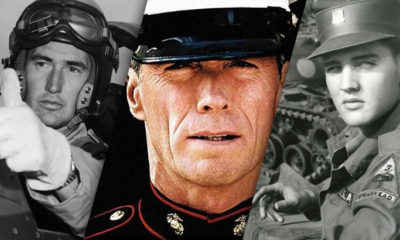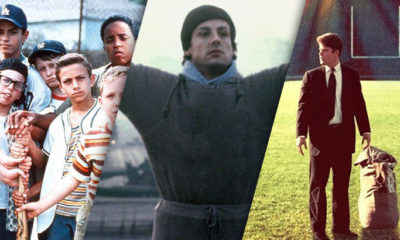TRENDING
Rare Historical Vietnam War Photos
Published
5 years agoon
The Vietnam War occurred in Vietnam, Laos, and Cambodia from November 1, 1955 to the fall of Saigon on April 30, 1975. There was turmoil abroad and protest on the homefront.
Click NEXT to view some of the most iconic Vietnam moments ever captured in history.
Click NEXT to view some of the most iconic Vietnam moments ever captured in history.

President Dwight D. Eisenhower (1953-1961)

President Eisenhower preparing to address the nation in his iconic “Farewell Address.” January 17th, 1961
Vice President Johnson Meets With Vietnamese President (1961)

Vice President Lyndon B. Johnson meets with Vietnamese President Ngo Dinh Diem at Independence Palace, Saigon, as part of his Goodwill Tour of Southeast Asia. May 1961
Napalm Strikes, Perfume River (1963)

Napalm air strikes raise clouds into gray monsoon skies above the Perfume River toward Hue in Vietnam. February 28th, 1963
President Kennedy Meets With Military Leaders (1963)

President John F. Kennedy (1961-1963) meets with U.S. Secretary of Defense (center) and U.S. Army Chief of Staff General Maxwell Taylor (left) prior to their visit to South Vietnam to review U.S. Military efforts. September 24th, 1963
Binh Gia (1964)

As part of its winter-spring offensive, the Viet Cong sent its newly created 9th Division to attack South Vietnamese forces at Binh Gia. The attack lasted for 4 days and would eventually be broken by U.S. bombers. 1964
A-1 Skyraider (1964)

A low flying A-1 Skyraider drops 500 lb bombs on a Viet Cong stronghold. December 26th, 1964
Burning Draft Card (1964)

As a symbol of protest in opposition to involvement in the Vietnam War, thousands of young American men began burning their draft cards. May, 1964.
Community Relations (1964)

A.G.I. talking to Vietnamese natives on the road while escorting a supply convoy. 1964
President Johnson Signing HJ RES 1145 (1964)

President Johnson (1963-1969) signed House Joint Resolution 1145, otherwise known as the Tonkin Gulf Resolution expanding the president’s authority to increase U.S. involvement in the war between North and South Vietnam. Johnson, and later Nixon, would go on to use the resolution as the legal rectification for their military policies in Vietnam. August 7th, 1964
Photo Of Viet Cong Leader, Ho Chi Minh (1964)

United States troops holding a photo of Ho Chi Minh, who organized the Viet Cong in the late 1950’s.
MLK, Beyond Vietnam (1964)

“Beyond Vietnam: A Time to Break Silence” is an anti-Vietnam war and pro-social justice speech delivered by Martin Luther King Jr. The major speech at Riverside Church in New York, New York, followed several interviews and several other public speeches in which King came out against the war in Vietnam and the policies that created the war. April 4th, 1967
173rd Airborne Brigade (1965)

Huey helicopters carrying troops of the U.S. 173rd Airborne Brigade get help landing on a road near the Montagnard village of Plei Ho Drong. August, 1965.
Giant Centipede (1965)

The Viet Cong weren’t the only thing U.S. troops had to worry about in the jungle. Here is a marine holding a giant centipede. 1965
U.S. Helicopters Provide Cover (1965)

Hovering U.S. helicopters dump machine gun fire into the tree line to cover advancing South Vietnamese ground troops in route to attack a Viet Cong camp eighteen miles north of Tay Ninh. March, 1965
Fallen Soldiers (1965)

Flag-draped coffins of eight American Servicemen killed in attacks on U.S. military installations in South Vietnam, on February 7, are placed in transport plane at Saigon. February 9th, 1965
U.S. First Cavalry Air Mobile (1965)

Elements of the U.S. First Cavalry Air Mobile division in a landing craft approach the beach at Qui Nhon, 260 miles northeast of Saigon, Vietnam. September, 1965
Washington Monument (1965)

Thousands attend a rally on the grounds of the Washington Monument to hear Ernest Gruening, a Democratic Senator from Alaska, and other speakers discuss U.S. policy in Vietnam. April 17th, 1965
Jets Dropping Napalm (1965)

U.S. jets dropping napalm on Viet Cong stronghold. 1965
Red Beach, Saigon (1965)

Marines wade ashore with heavy equipment at first light at Red Beach near Da Nang in Saigon. April 10th, 1965
Carpet Bombing (1965)

A U.S. B-52 stratofortress drops a load of 750-pounds bombs over a Vietnam coastal area during the Vietnam War. November 5th, 1965
Vietnamese Target Practice, Thanh Tri (1965)

Company #6 of the Yen My Commune using overhead targets to practice firing ahead of speeding aircraft. September, 1965.
Batman Selling War Bonds (1966)

In this 1966 propaganda commercial, Batman, played by actor Adam West, urged kids to buy government savings bonds to support the Vietnam War.
U.S. Marine CH-46 Sea Knight Down In Flames (1966)

After being hit by enemy ground fire during Operation Hastings, just south of the Demilitarized Zone between North and South Vietnam. The helicopter crashed and exploded on a hill, killing one crewman and 12 Marines. July 15, 1966
Ho Chi Minh Trail (1966)

Troops walk the Ho Chi Minh trail in the Truong Son Mountains, which form the 750-mile long spine of Vietnam, stretching across much of the country’s western border. 1966
Pedestrians Cross Hue Bridge (1966)

Pedestrians cross the destroyed Hue Bridge in Hue, Vietnam. 1966
White Phosphorus (1966)

A U.S. Air Force Douglas A-1E Skyraider drops a white phosphorus bomb on a Viet Cong position in South Vietnam. 1966
Korean Kittens (1966)

The singing group the “Korean Kittens” appear on stage at Cu Chi, Vietnam, during the Bob Hope USO Christmas show, to entertain U.S. troops of the 25th Infantry Division. 1966
Machine Gun Hill (1966)

A U.S. Marine fires his M60 machine gun, concealed behind logs and resting in a shallow hole, during the battle against North Vietnamese regulars for Hill 484, just south of the demilitarized zone. October 10th, 1966
Soldiers Drinking Rain (1966)

Potable drinking water was a valued resource in the jungle. These U.S. troops take advantage of a storm by drinking rain water. 1966
503rd Infantry (1966)

Soldier of C company, 2nd battalion, 503rd infantry, 173rd airborne brigade. January 3rd, 1966
Physical Exams, Haiphong (1967)

New recruits undergoing physical exams in Haiphong. 1967
Anti War Protest, The Pentagon (1967)

Protesters are rushed by guards as they attempt to breach a security line at the Pentagon. October, 1967.
Phuong Dinh Railroad Bypass Bridge Bombing (1967)

U.S. Navy Douglas A-4E Skyhawks from Attack Squadrons VA-163 Saints and VA-164 Ghost Riders attack the Phuong Dinh railroad bypass bridge, 10 kilometers north of Thanh Hoe, North Vietnam. September 10, 1967.
Empty Artillery Shells (1967)

Empty artillery cartridges pile up at the artillery base at Soui Da, some 60 miles northwest of Saigon, at the southern edge of War Zone C. March 8th, 1967.
Pro Vietnam Protesters (1967)

Part of a crowd of pro-Vietnam War demonstrators hold up signs and American flags in support of U.S. policy in Vietnam in Wakefield, Massachusetts. October 29th, 1967.
Muhammed Ali Rejects The Draft (1967)

With the United States at war in Vietnam, Ali refused to be inducted into the armed forces, saying “I ain’t got no quarrel with those Vietcong.” On June 20, 1967, Ali was convicted of draft evasion, sentenced to five years in prison, fined $10,000 and banned from boxing for three years. He stayed out of prison as his case was appealed and returned to the ring. October 26th, 1970
Spring Mobilization To End The War (1967)

Several thousand participate in the Spring Mobilization to End the War, a network of mass demonstrations across the country in cities such as San Francisco and New York. It’s estimated that as many as 60,000 marched in San Francisco and 125,000 in New York. April 15th, 1967
American Cavalry Helicopter (1968)

Operation Pegasus, Spring, 1968, an American 1st Cavalry helicopter airlifts supplies into a marine outpost.
Tunnels of Chu Chi (1968)

An immense network of underground tunnels located in the Chu Chi district of Ho Chi Minh city, Saigon. Part of a much larger network of tunnels that run through the country. They served as the Viet Cong’s base of operations for the 1968 Tet Offensive. 1968
Tet Offensive (1968)

The Tet Offensive was one of the largest military campaigns of the Vietnam War. Tet Offensive consisted of surprise attacks on civilian and military command and control centers by the Viet Cong against the South Vietnamese and United States Armed Forces. 1968
Veterans Protest Vietnam War (1968)

Philadelphia, PA, veterans demonstrate their opposition to the Vietnam War. 1968
M-48 Patton With mine Rollers (1968)

M-48 Patton with mine rollers designed to detonate enemy explosives ahead of U.S. infantry. 1968
Heading Out On Patrol (1968)

A helicopter full of Marines heading out on patrol lifts off the airstrip at the Khe Sanh combat base. June 27th, 1968
Catholic Church (1968)

U.S. Marines pass a Catholic church as they patrol near Danang, Vietnam, during the Vietnam War. 1968
Freedom And World Peace (1969)

Banners of appreciation from the Vietnamese decorate the dock at Danang where a farewell ceremony was held by the Vietnamese Government for departing Marines of the 1st Battalion 9th Regiment. July 14th, 1969
Moratorium March Against The Vietnam War (1969)

More than 500,000 people marched down Pennsylvania Ave. to demonstrate their opposition to the Vietnam War on November 15th, 1969.
President Nixon and Henry Kissinger (1969)

President Richard Nixon (1969-1974) boards a helicopter joining with National Security Advisor Henry Kissinger following a meeting with U.S. troops from the 1st infantry division. This was Nixon’s only visit to Vietnam as President. July 30, 1969
Discarding Medals (1969)

In Washington D.C., veterans protest the fighting in Indochina by discarding their medals and uniforms over the fence at the U.S. Capitol.
Mekong Delta (1970)

Cambodia Announcement (1970)

President Richard Nixon (1969-1974) gave formal authorization to commit U.S. combat troops to cooperate with South Vietnamese units against communist sanctuaries in Cambodia. A wave of protests would follow, one demonstration would result in the notorious Kent State shootings, where Army National Guard troops killed four students. April 30, 1970
John Kerry Senate Hearing (1971)

John Kerry, who would later go on to run for President, and serve as Secretary of State (2017-2017) became a prominent critic of the Vietnam war after his return in 1969. Kerry won an early transfer out of the conflict due to his 3 purple hearts. He also won a silver star. 1971
Laotian Guerrillas (1971)

Laotian guerrillas haul supplies by elephant and foot to NVA troops near Route 9 in southern Laos during South Vietnam’s attempted interdiction of the trail. 1971
Resist The Draft (1971)

Sammy Davis (1972)

Entertainer Sammy Davis Jr. performs for members of the 1st Cavalry Division (Airmobile) in an undisclosed location in Vietnam. February of 1972.
John Lennon (1940-1980)

Co-founder of the Beatles, entertainer, John Lennon is one of histories most prominent anti war activists. He and his wife Yoko Ono are known for their famous “bed ins” and involvement in the organization of massive protests at the Democratic National Convention among other acts of deviance. Seen here giving his iconic “V” peace sign (V for Vietnam). 1971
Punji Stakes, Guerrilla Outpost, 1972

An outpost on the Vietnam-Cambodia boarder equipped with poison punji stakes. Sharpened and hardened with fire, such booby traps were meant to wound enemy troops not kill. Wounded soldiers would slow down their unit and medivacs gave away their position. 1972
Vietnam War Protest (1972)

Protesters demonstrating against the Vietnam War march toward MacArthur Park, Los Angeles. April 22nd, 1972
Downed U.S. Navy Plane, Hanoi (1972)

Militia members sort through the wreckage of a downed U.S. Navy Plane. This is believed to be the debris of a A-7C Corsair flown by Lt. Stephen Owen Musselman that was hit by SAMs south of Hanoi while supporting a B-52 bombing mission. September 10th, 1972
Activists Hiding Identities (1972)

Activists meet in the Nam Can forest, wearing masks to conceal their identity. 1972
Lowering U.S. Flag (1972)

As the U.S. Army base at Long Binn is turned over to the South Vietnamese Army, the American Flag is lowered. The base is located 12 miles north of Saigon. November 11th, 1972
Bridge Repair Workers (1973)

Workers discuss repairs of the Ham Rong Bridge following a bombing, in Central North Vietnam, 1973.
Agent Orange (1961-1971)

Agent Orange was part of the United States Herbicidal Warfare program. In mid 1961, President Ngo Dinh Diem of South Vietnam asked the United States to conduct aerial herbicide spraying in his country. Agent Orange was manufactured for the U.S. Department of Defense primarily by Monsanto Corporation and Dow Chemicals.
Ellsberg Case Dismissed (1973)

While employed by the RAND Corporation, precipitated a national political controversy in 1971 when he released the Pentagon Papers, a top-secret Pentagon study of U.S. government decision-making in relation to the Vietnam War. Due to governmental misconduct and illegal evidence gathering, and the defense by Leonard Boudin and Harvard Law School professor Charles Nesson, Judge Byrne dismissed all charges against Ellsberg. May 11th, 1973
POW Reunited With Family (1973)

Released prisoner of war Lt. Col. Robert L. Stirm is greeted by his family at Travis Air Force Base in Fairfield, California. March 17th, 1973
Peace Talks (1973)

Four delegations sit at the table during the first signing ceremony of the agreement to end the Vietnam War. Clockwise, from foreground, delegations of the Unites States, the Provisonal Revolutionary Government of South Vietnam, North Vietnam and South Vietnam. January 27th, 1973
John McCain Released (1973)

John S. McCain is escorted by Lt. Cmdr. Jay Coupe Jr. to Hanoi’s Gia Lam Airport after the POW was released. McCain is now a sitting senator in the United States Senate. March 14th, 1973
Women Fishing (1974)

During the Vietnam War, women were tasked with doing jobs normally reserved for men. Here women can be seen hauling heavy fishing nets in the Mekong River, 1974.
U.S. Civilians, Saigon, 1975

U.S. Civilians in Saigon, 1975.
Abandoned ARNV Uniforms (1975)

Combat boots litter the road on the outskirts of Saigon, abandoned by ARVN soldiers who shed their uniforms to hide their status. April 30th, 1975
Jane Fonda, Hanoi Jane (1975)

Actress Jane Fonda speaking at an anti-vietnam war conference in the Hague. She earned the nickname “Hanoi Jane.” January 1975
Evacuees (1975)

CIA employee (probably O.B. Harnage) helps Vietnamese evacuees onto an Air America helicopter from the top of 22 Gia Long Street, a half mile from the U.S. Embassy. April 25, 1975
Saigon Water Front (1975)

Evacuees board a boat in the Saigon waterfront as communist forces close in on the city. 1975
Making Room For Evacuation Flights (1975)

U.S. Navy personnel aboard the USS Blue Ridge push a helicopter into the sea off the coast of Vietnam in order to make room for more evacuation flights from Saigon. April 29th, 1975
U.S. Embassy, Saigon (1975)

Mobs of Vietnamese people scale the wall of the U.S. Embassy in Saigon, Vietnam, trying to get to the helicopter pickup zone, just before the end of the Vietnam War. April 29th, 1975
President Gerald Ford (1974-1977) Tulane University

President Gerald Ford speaking at Tulane University in New Orleans, Louisiana, considered to be the first public announcement of the end of the Vietnam War. April 23rd, 1975
More From Auto Overload
-


Fastest Shrinking Cities In The U.S.
-


Celebrities Who Served In The Military
-


Incredibly Timed Sports Photos
-


Top Colleges To Avoid In America
-


He-e-e-e-re’s Johnny Carson’s Secrets From The Tonight Show
-


’90s Stars Back Then and Today
-


Wild Australia Photos
-


Start ‘Em, Sit ‘Em Week 3: Fantasy WRs
-


Most Insane Private Jets On The Planet
-


Can You Guess These Sports Movies?
-


The Most Unique People in the World
-


Dog Breeds Not Meant For Your Home

